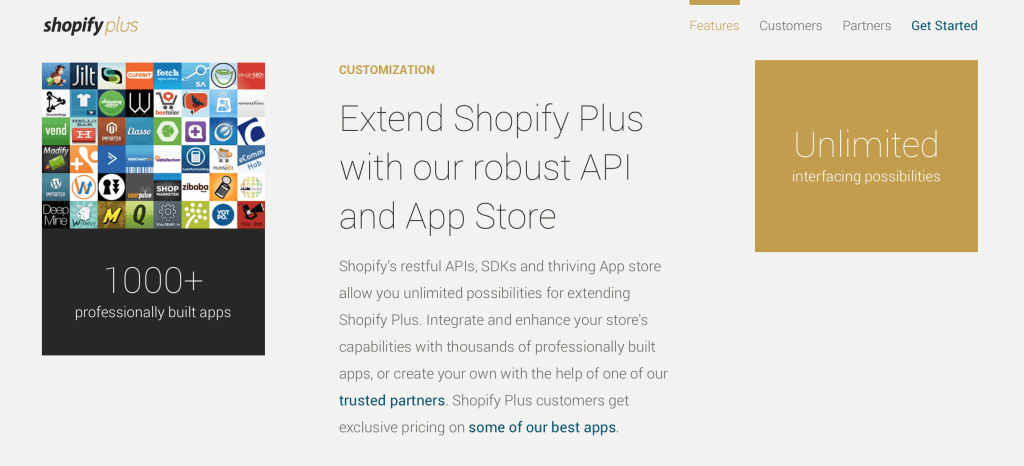Why Migrating to Shopify Plus Instead of Magento 2 is the Path of Least Resistance (And the Path of Greatest ROI)
Have you wondered why more and more enterprise-level brands are making the switch from Magento to Shopify Plus?
We’re asking ourselves the exact same question.
Here at Blue Stout, we’re keeping an eye on the steady stream of Shopify Plus converts as Magento 1 prepares to officially phase out in the Fall of 2018.
While companies like Bombas Socks and Stowaway Cosmetics are experiencing what the Shopify Plus hype is all about, thousands of other Magento clients are stopped at a fork in the road wondering if they should undergo a costly replatform to Magento 2 or explore other options.
Let’s not forget that once Magento 1 phases out completely, community and enterprise users will lose all customer and app store support along with their access to upgrades and security patches.
The robust community that Magento users have grown so accustomed to over the years will essentially undergo a reset due to profound alterations to the platform’s “architecture and deep technical competencies”. (Source)
So, with just over a year on the clock, what should Magento users do to ensure they’re not left behind? If you’re not sure where to start your search, we know just the place.
For those who want the biggest bang for their buck, Shopify Plus has designed a limited-time offer to make the move from Magento quick, painless, and extremely cost-effective.
Here’s the deal. Shopify Plus is offering Magento 1.x users 6 months free, along with assisted migrations, if they switch platforms before June 30, 2017. Now, you can dodge the steep implementation costs of Magento (typically $100K – $300K, oh my) for a nice, soft landing with the industry’s fastest growing platform.
While we let the sweetness of the deal sink in a little deeper, let’s take a closer look at why it makes sense for Magento users to consider Shopify Plus.
Dedicated Hosting & Site Security is Included with Shopify Plus

Since your ecommerce platform is the foundation of your business, you want it to be the best, but you also don’t want to fork out unnecessary resources that could be supplementing other profitable initiatives for your business.
Hosting and site security are prime opportunities to save with Shopify Plus.
If your site is built on Magento, you’re already well aware that hosting is not included in your annual fee. You are on your own to find a hosting solution which can cost upwards of $4,500/mo. for multiple, dedicated servers. (Of course, this number also depends on how big your store is and how many resources it requires.)
Magento is also known for being a very heavy platform to host. It has a lot of code, requires a lot of resources, and getting it to run quickly requires extra optimization.
Magento 2 attempts to make the platform more user-friendly for clients who lack development chops, but the gap in usability between Shopify Plus and Magento 2 remains. The core difference between the two is clear: Shopify Plus designed their platform around seamless UX from the very beginning while Magento is busy circling back to correct their afterthought.
In fact, even with Magento 2’s augmented ease-of-use, usability tests have still shown Shopify Plus to be the preferred option for both back-end users and customers alike.
And on top of making sure the performance is up-to-speed, you also have to think about your site’s security. With Magento, PCI compliance falls on your shoulders.
That means you need to determine what level of PCI compliance your store requires, then make sure your hosting provider has an environment that meets your security needs.
All of this is adding up to a lot of work, a lot of manpower, and a lot of hours. Are you seeing the theme we’re seeing?

Shopify Plus is so much easier.
They set it all up for you. You don’t have to figure out any of the details. Hosting is included in your fee. And all of their sites are, by default, Level 1 PCI compliant. They do annual on-site compliance assessments and continuous risk management, too, so you don’t even have to worry about figuring out those details or maintaining a regular assessment of your site.
That’s a lot of time saved just from the get-go.
Shopify Plus is the more cost-effective solution in terms of hosting because of the value received from the features of their hosting solution. For the fee you’ll pay, their hosting offer is top-tier.
With Magento, you’ll end up spending quite a bit of time just lining up your hosting ducks. And that’s billable time. Not to mention that now you’re involved with an additional service provider, which will require management
Having your store on a hosted platform is also better when it comes to streamlining your customer experience but I’ll talk about that further down in the “customizations” section.
Third-Party Integrations Aren’t a Pain
One of the best things about Magento is their extension marketplace. It’s where you’ll find all of the apps that make your store function like a custom online store should.
But Magento apps are not exactly turnkey solutions. Meaning, the majority of them take a little bit (or a lot) of coding to get up and running. If you have a dev agency, then setting up these apps to run with your store is going to cost you.

Shopify Plus apps are much easier to set up. This super-detailed case study from William Harris of his experience migrating Dollar Hobbyz, an ecommerce site doing over 3,000 transactions per month, from Magento to Shopify Plus. In it, he tells exactly how easy Shopify Plus apps are to use in comparison to Magento:
With Shopify Plus, I’ve run into very few apps that actually required a developer. – @wmharris101Harris goes on to say that while he did have to fork out in order to get his custom search function running exactly how he wanted, he was able to install Zopim chat, Zendesk support, Signifyd fraud protection, and LuckyOrange heatmaps all without the help of a developer.
Why is this so great?
First, you eliminate your dependence on your development team. So if you need an app installed for your marketing person to use, he/she should be able to set it up on their own.
Second, you free up these resources for other more important things. Even though an app install may seem like a relatively “small” task, they can quickly turn expensive in Magento.
If the extension conflicts with your module, installing the extension (app) will need heavy customization. Something that should be “small” can quickly multiply to cost you thousands of dollars in development hours.
![[This is where your “small app integration” dollars could be going...(source)]](http://bluestout.com/wp-content/uploads/2016/07/developer.gif)
So having cleaner, turnkey apps will give you back these “thousands of dollars” to utilize somewhere else.
Maintaining your site is now more efficient, and you don’t need as much focus on backend development.
Shopify Plus Allows You to Consistently Maintain a Quality Customer Experience
Speaking of backend development…ever experienced a bug in your Magento store?
Cue the customer complaints. Cue the headaches. Cue the stress and frenzy to fix the problem.
Resolving a bug tends to go something like this:
- Customer complaint notifies you of a problem (potential software fault)
- Immediately get dev team on a reconnaissance mission
- Team finds 2 or 3 potential causes
- Team needs to test all use cases for those 2-3 possibilities
- Team finally finds the culprit and gets started correcting course
- Site experiences downtime while fix is deployed
- Fix is live and requires testing
- Test: if problem is found, go back to Step 3 and repeat
- If it works, high-five your devs then pay their hourly rate multiplied by all of the above hours
- Complain about Magento and wonder if there is a more efficient solution
Forrester research claims that “In the 21st century, successful companies will rise and fall based on their software.”
So putting constant bandaids on your Magento bugs is not an option if you want to scale.
The reason that Magento extensions are less stable is because there isn’t a very high standard placed on the quality.
That’s where Shopify Plus wins. Unstable integrations between third-party vendors (like you’ll find more of with Magento) lead to costly inefficiencies, which poorly represent your brand and frustrate your customers.
From the beginning, Shopify Plus has prioritized quality and maintained a high standard on what apps they approve to be available to their customers. By holding all the apps to a high standard, this keeps out anything that will have excessive bugs or faults.
You Don’t Have to Compromise Flexibility or Manageability with Shopify Plus Scripts Customizations

When you can’t find the app you need in the Shopify Plus or Magento marketplaces, that means you have to go custom – build your own to fit your needs.
Previously, Shopify Plus clients didn’t have much access to deep customization because Shopify Plus is a hosted platform which didn’t allow FTP or database access. All changes developers wanted to make had to go through the front end or through the API.
Not anymore! Shopify Plus has recently released Scripts, which frees up developers to write their own customizations. Shopify Scripts allows developers to ‘enter’ Shopify’s servers and create their own customizations.
By utilizing custom scripts you can greatly reduce the time and costs associated with building your customizations, and balance the needs of your business with those of your customers. Scripts gives you advanced custom functionality without compromising flexibility or maintainability.
That means any customization you build with scripts will run on the server and integrate with the platform in a seamless way. Because Scripts run within Shopify’s environment (unlike apps), they also have the advantage of achieving tasks without resorting to workarounds that can lead to even larger headaches elsewhere. (source)
Building out customizations in Magento is less efficient because you have no standard of code. You can hire a developer to build a customization for you, but since you are running everything on your own server, there’s no one to tell you: “hey, that code isn’t the best”.
So even if your customization is implemented and working just fine now, it could very well begin acting up when you have a spike in traffic or a rare/specific use case from a customer.
Shopify Plus’ hosting and server setup ensures you don’t have to worry about those problems – even with your custom developments. Removing the extra level of IT maintenance is another way that Shopify Plus is a more efficient platform solution for enterprise-level companies.
Migrating Your Magento Store Is FREE (For Now & With a 2 Year Contract)
So, now that we’ve made the case of why Shopify Plus pricing is well worth it, let’s get back to the limited-time offer I mentioned earlier.
Instead of what would essentially be restarting with Magento 2, and incurring all of the costs that come along with that, Shopify Plus will migrate the data (customers, products, order history, etc) from your Magento store over and waive 6 months worth of platform fees for free.
There’s one caveat. In order to take advantage of this deal, you’ll have to sign a two-year contract.
But, if you’re going to be “locked into” a vendor, wouldn’t you rather it be the vendor that’s going to take your business to the next level instead of one that’s going to have you opening your wallet to cover additional costs on a daily basis?
Shopify Plus has a tremendous track record of building a wonderful product (on both ends) that keeps the most important needs of their clients top of mind, turning a perceived risk into a rare opportunity.
You can check out their store migration offer and details here.
If you’re still on the fence about migrating your store to Shopify Plus, we get it. A store migration is a very expensive and demanding initiative.
So our CEO has set aside some times for those of you who’d like to find out if a switch is the proper fit. . Whether you migrate or not, you’ll still walk away from the conversation with valuable insider info from one of the industry’s most prominent authorities. Click below to schedule a free 45-minute strategy session:







